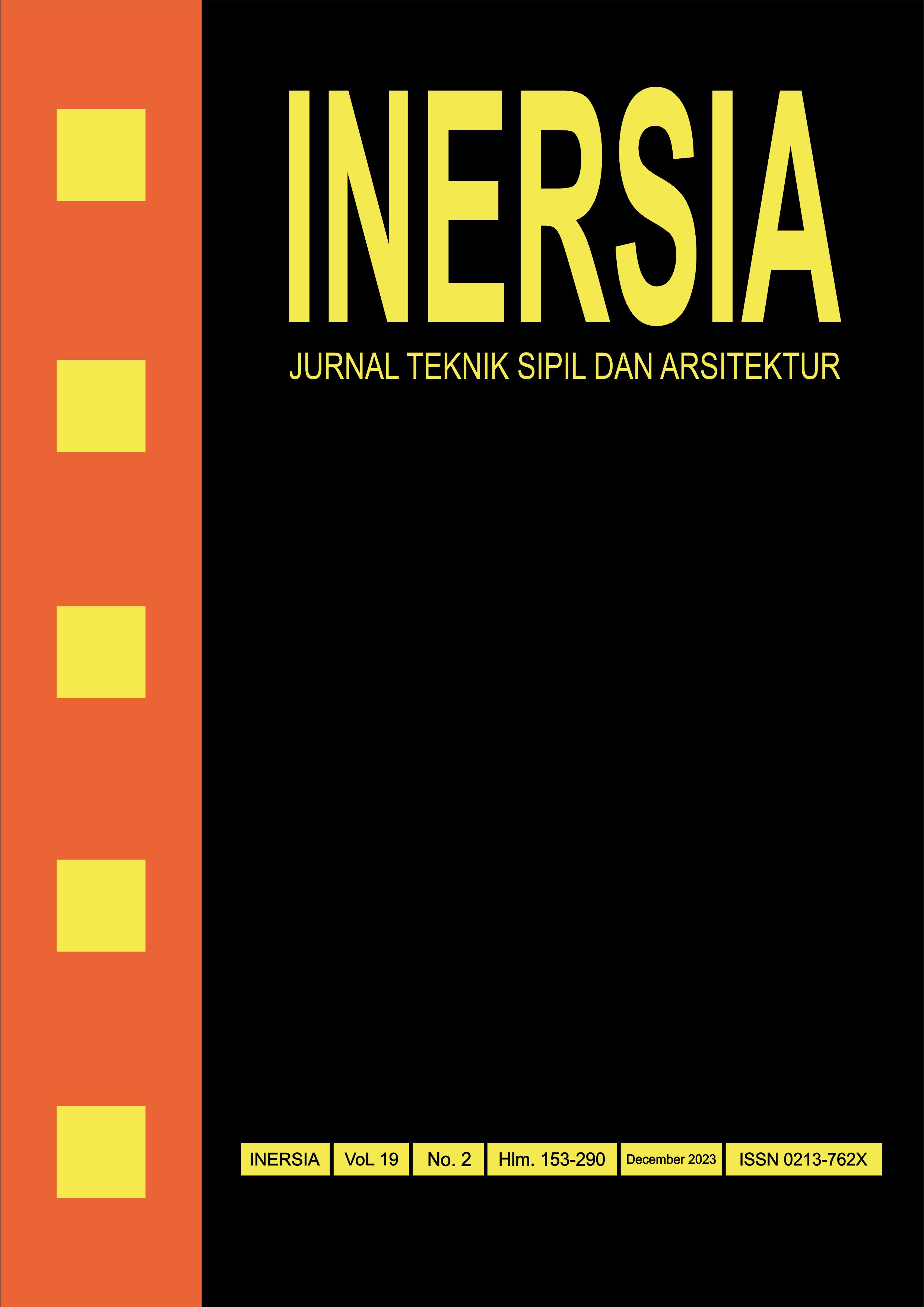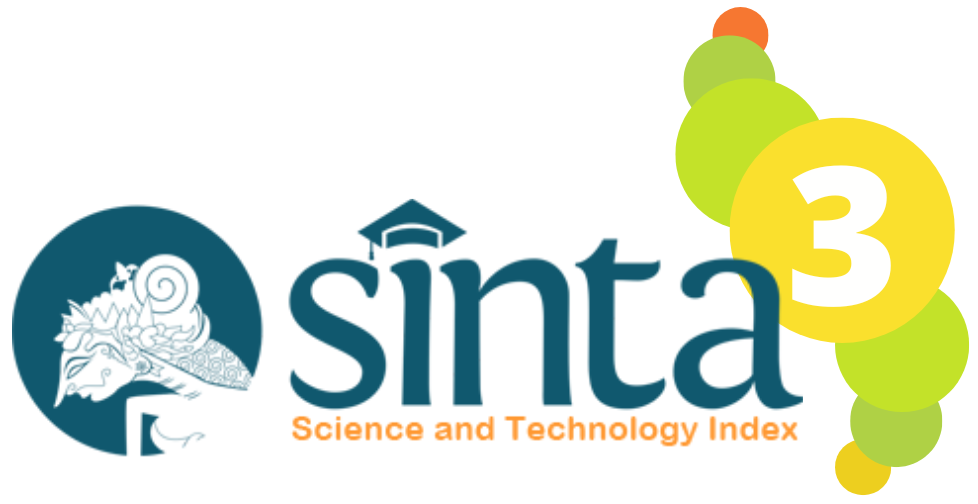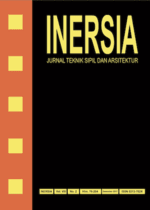Studies of Improving Drinking Water Quality in the Kalurahan Banaran Kabupaten Kulon Progo Using Porous Concrete Filter
DOI:
https://doi.org/10.21831/inersia.v19i2.64125Keywords:
Concrete Filter, Iron Concentration, Turbiditiy, Quality of Drinking Water.Abstract
Some citizens of the Kalurahan Banaran Kabupaten Kulon Progo everyday use water that has an iron content (Fe) of 8.8 mg/L and a turbidity of 120 NTU, which is above the limit set by the Minister of Health's Regulation RI Number: 2 Tahun 2023 on the Quality Requirements of Drinking Water. To solve this problem, research has been conducted to reduce Fe and turbidity by using porous concrete filters. Three models of porous concrete A (porousity 0.42), B (porousity 0.44), and C (porousity 0.46), were used to filter water samples using two aerator diffusers at speeds of 3 L/h and 6 L/hour on each porous concrete filter. The results of the study showed that at an aeration rate of 3 L/hour, there had been a successive decrease in turbidity and Fe from 14.9 NTU to 1.38 NTU and 1.64 mg/L to 0.14 mg/L (filter A); 80 NTU to 0.5 NTU and 6.55 mg/L to 0.02 mg/L (filter B); 80 NTU to 0.1 NTU and 6.5 mg/L to 0 mg/L (filter C). For an aeration rate of 6 L/hour, there had been a successive decrease in turbidity and Fe from 80 NTU to 0.82 NTU and 6.55 mg/L to 0.05 mg/L (filter A); 89.8 NTU to 0.28 NTU, and 7.8 mg/L to 0.01 mg/L (filter B); 80 NTU to 0.28 NTU and 6,55 mg/L to 0 mg /L (filter C). The results show that the porous concrete filter can be considered an alternative to drinking water treatment in the Kalurahan Banaran Kabupaten Kulon Progo.
References
S. L. Young et al., "Validity of a four-item household water insecurity experiences scale for assessing water issues related to health and well-being," Am. J. Trop. Med. Hyg., vol. 104, no. 1, pp. 391–394, 2021, doi: 10.4269/AJTMH.20-0417.
M. K. c Murugan Muthu a, Manu Santhanam b, "Pb removal in pervious concrete filter: Effects of accelerated carbonation and hydraulic retention time," Constr. Build. Mater., vol. 174, pp. 224–232, 2018, [Online]. Available: https://www.sciencedirect.com/science/article/pii/S0950061818309243." .
and H. K. L. G. M. Kim, J. G. Jang, H. R. Khalid, "Water purification characteristics of pervious concrete fabricated with CSA cement and bottom ash aggregates," Constr. Build. Mater., vol. 136, pp. 1–8, 2017, [Online]. Available: https://www.sciencedirect.com/science/article/abs/pii/S0950061817300314." .
A. Azad, A. Saeedian, S. F. Mousavi, H. Karami, S. Farzin, and V. P. Singh, "Effect of zeolite and pumice powders on the environmental and physical characteristics of green concrete filters," Constr. Build. Mater., vol. 240, p. 117931, 2020, doi: 10.1016/j.conbuildmat.2019.117931.
V. Alimohammadi, M. Maghfouri, D. Nourmohammadi, P. Azarsa, R. Gupta, and M. Saberian, "Stormwater runoff treatment using pervious concrete modified with various nanomaterials: A comprehensive review," Sustain., vol. 13, no. 15, 2021, doi: 10.3390/su13158552.
C. R. Krishnan, M. Santhanam, M. Kumar, and M. Rangarajan, "Iron oxide-modified pervious concrete filter for lead removal from wastewater," Environ. Technol. Innov., vol. 28, p. 102681, 2022, doi: 10.1016/j.eti.2022.102681.
K. Lertsuwan et al., "Differential effects of Fe2+ and Fe3+ on osteoblasts and the effects of 1,25(OH)2D3, deferiprone and extracellular calcium on osteoblast viability under iron-overloaded conditions," PLoS One, vol. 15, no. 5, pp. 1–23, 2020, doi: 10.1371/journal.pone.0234009.
E. V. and R. Caspeele, "Conformity control of concrete durability parameters and its filtering effect on the design service life," Struct. Concr., vol. 23, no. 2, pp. 669–681, 2022, [Online]. Available: https://onlinelibrary.wiley.com/doi/abs/10.1002/suco.202100459." .
A. Abdullayev, M. F. Bekheet, D. A. H. Hanaor, and A. Gurlo, "Materials and applications for low-cost ceramic membranes," Membranes (Basel)., vol. 9, no. 9, 2019, doi: 10.3390/membranes9090105.
B. Kamulyan, F. Nurrochmad, R. Triatmadja, and S. Sunjoto, "Capacity of Concrete Sand Filter to Treat High Turbid Water," Int. Conf. Sustain. Dev. Water Wastewater Treat., 2009, [Online]. Available: https://opac.perpusnas.go.id/DetailOpac.aspx?id=45451.
T. Poerio, E. Piacentini, and R. Mazzei, "Membrane processes for microplastic removal," Molecules, vol. 24, no. 22, 2019, doi: 10.3390/molecules24224148.
T. J. Mohammed and E. Shakir, "Effect of settling time, velocity gradient, and camp number on turbidity removal for oilfield produced water," Egypt. J. Pet., vol. 27, no. 1, pp. 31–36, 2018, doi: 10.1016/j.ejpe.2016.12.006.
and S. R. S. A. N. Marsidi, H. A. Hasan, "A review of biological aerated filters for iron and manganese ions removal in water treatment," J. Water Process Eng., vol. 23, pp. 1–12, 2018, [Online]. Available: https://www.sciencedirect.com/science/article/pii/S2214714417306839." .
L. J. Mohammed and K. M. Omer, "Dual functional highly luminescence B, N Co-doped carbon nanodots as nanothermometer and Fe3+/Fe2+ sensor," Sci. Rep., vol. 10, no. 1, pp. 1–12, 2020, doi: 10.1038/s41598-020-59958-5.
Downloads
Published
How to Cite
Issue
Section
License
Authors who publish with INERSIA journal agree to the following terms:
- Authors retain copyright and grant the INERSIA journal right of first publication with the work simultaneously licensed under Creative Commons Attribution License (CC BY 4.0) that allows others to share the work with an acknowledgment of the work's authorship and initial publication in this journal.
- Authors can enter into separate, additional contractual arrangements for the non-exclusive distribution of the published version of the work (e.g., post it to an institutional repository or edit it in a book), with an acknowledgment of its initial publication in this journal.
- Authors are permitted and encouraged to post their work online (e.g., in institutional repositories or on their website) before and during the submission process, as it can lead to productive exchanges, as well as earlier and greater citation of published work.

INERSIA by https://journal.uny.ac.id/index.php/inersia was distributed under a Creative Commons Attribution 4.0 International License











